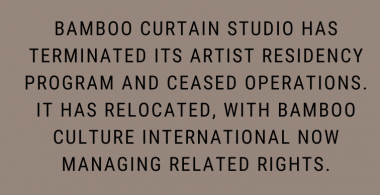River Cruise in Plum Tree Creek | 2013.10.22-2014.4.27

Rivers and streams have always played an important role in the development of agriculture, industry, and commercein our civilization. They are key components to our irrigation systems and industrial water supplies, but are also present when their own courses are altered, terminated, and masked underground as our society progresses and as infrastructures are built.
What was crystal clear is now replaced by muddiness; what used to be a site for gathering and playing is now hidden under heavy, cold concrete. Rivers and streams have been fulfilling our wishes for a bright future in silence as we ruthlessly consume its wealth of resources.
Education on the environment as well as education for all arethe core values of the National Science Education Center. This special exhibition project is organized as a reflection on the inseparable relationship between human activities, the development of civilization, the ecology of watersheds,and environmental change. Collaborating with Bamboo Curtain Studio, artistic languages and alternative viewpoints are incorporated. As an extension from Bamboo Curtain Studio’s locally basedproject, Art as Environment: A Culture Action at the Plum Tree Creek, the heart of the exhibition lies in the hopeful possibility of a friendly connection between humans and the environment, and in the positive environmental transformation through human actions. Through hands-on activities, artistic interpretations, and models for an environmentally-aware community, the exhibition sets out to encourage audiences to think about their own relationships with the environment and to furthermore imagine a green home for all living beings to coexist.
River Cruise in Plum Tree Creek is a special exhibition at the National Science Education Center that depicts the different faces of Plum Tree Creek. Through a series of interpretive installations, the exhibition aims atenriching the visitors’ sensory experiences. The downstream up to the middle reaches of the riveris heavily polluted, its presence ignored and forgotten by its own inhabitants; whereas the midstream to the upstream section of the water becomes clear and lively again, revealing the original purity of the river. Developed from the Art as Environment: A Culture Action at the Plum Tree Creek and referencing the everyday lives by Plum Tree Creek some forty years ago, the exhibition incorporates board games, sounds, images, videos, small-scaled models, and art objects to tell the story of the river. Programs such as Stories of River, the Shape of the Village, the Green Map, and public art projects with a local elementary school are organized as part of the exhibition project to help raise awareness aboutour delicate and disappearing river environment.
Opening Reception: 2013.10.22 14:30
Exhibition Period: 2013.10.22-2014.4.27
Location: 3rd Floor, West Wing, National Science Education Center
About the Exhibition
The Entrance:
Entering Plum Tree Creek through the culvert.
City of Bedrooms:
Houses, apartment buildings, and high-rises come into view as one enters Zhuwei through the culvert from the mouth of Plum Tree Creek.Densely populated residential quarters provide people with everyday conveniences and furthermore reflect the current stage of development in Taipei. Easily accessible MRT trains and the beautiful scenery of the Tamsui River fulfill city folks’ need to strike a balance between nature and real life. Underneath it all, Plum Tree Creek flows quietly by, its presence visible and invisible at the same time.
City of Gardens:
Fields of vegetable gardens replace the cityscape as one passes through the neighborhoods in Zhuweiand enters the midstream of Plum Tree Creek. Inhabitants in this area are part-time farmers in search for an endearing relationship between the land and living. They learn about organic farming and grow in-season crops. A sense of community and human touch is fostered through the exchange of food and labor here.
The Secret Land:
There is a secluded path hidden behind the MiaojueTemple in Zhuwei. It is an ancient trail on which Zhuwei children treaded to go to school back in the days. Primordial bamboos and firs line the path for about one kilometer, guiding travelers towards Wu’s House Village.
Home in the Mountains:
Terraces, red brick houses, and small village dwellings occupy the area of Wu’s House Village. It has retained the traditional lifestyle of farming people and is like a tucked-away paradise removed from the rest of the world. Farmers and piggeries rely on Plum Tree Creek to grow their crops and keep their pigpens clean. Back whenrunning tap water wasn’t commonly installed, Plum Tree Creek played an important role in people’s lives here.
The Fountainhead:
Finally we enter the upstream of Plum Tree Creek. Aquatic creatures swim carelessly in the stream underneath tall and splendid trees that cover up the whole sky. One could discover more types of plants and insects of bigger sizes in this segment of Plum Tree Creek. Fountains bubble up from underground, as people tap the clear water down to lower grounds with systems of pipelines.
Arriving at Shuangxi:
After trekking up Plum Tree Creek, we now enter Shuangxi. Shuangxiis a highly dredged and artificially altered river that flows past the National Science Education Center. It improves the quality of life of the nearby residents by providing an ideal place for recreation. How do these residents view Shuangxi?
Video Room:
The film documenting the Environmental Art Movement at Plum Tree Creek is screened on loop here.
Classroom for Green Living:
With the National Science Education Center as a geographical center, visitors are invited to create their own maps for an environmentally friendly community.







